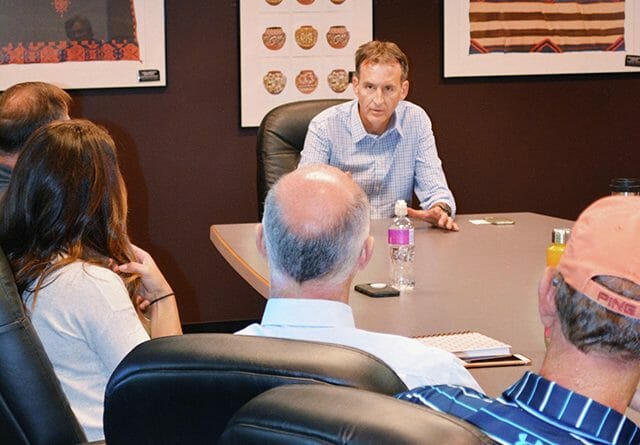Pawlenty Goes Back to School
Source: echopress.com
Photo Caption: Tim Pawlenty, Republican candidate for governor, talks to participants about improving the education system at a roundtable at the Alexandria Technical and Community College Monday.
Former Minnesota Gov. Tim Pawlenty, who is running for that office again, stopped at the Alexandria Technical and Community College Monday.
It wasn’t a typical campaign stump. Instead, Pawlenty said he was there to listen — something he did a lot of during an hour-long roundtable discussion with 15 participants. Attending were ATCC staff, manufacturing leaders, the Alexandria Area Economic Development Commission, Alomere Health, the Alexandria Lakes Area Chamber of Commerce and others, including state Sen. Bill Ingebrigtsen, R-Alexandria.
The crux of the conversation was the education system — how to improve it, what the state’s role should be and how, in Pawlenty’s words, to make two-year technical colleges “more robust” in attracting students to fill the worker shortage in Minnesota. Alexandria, he added, is a leader in the Upper Midwest when it comes to technical training.
Pawlenty, who served as governor from 2003-2011, said he wanted to convey the message that education has a “waterfall effect” in Minnesota. To enjoy a good quality of life, people need a job and to get a job, people need access to education that will provide them with the skills they need.
Pawlenty said that half of the students pursuing a degree in a four-year college drop out before they graduate, ending up deep in debt. He said that Alexandria serves as a good role model for aligning its two-year technical college with the high school to help students with their careers.
Those in the roundtable credited the success to a collaboration between local manufacturers, the college and the high school.
One concern ATCC leaders raised was the narrow gap between minimum wage jobs — $15 per hour in Minneapolis — and the low $20 per hour college graduates will earn in certain fields after getting a degree. The leaders said the difference is so small it’s causing some students to question whether getting a degree is worthwhile.
Pawlenty said there is a correlation between pay and how skilled workers must be. He noted that in Fairmount, students completing welding programs in high school were being offered $50,000 a year.
He added that the marketplace will adjust. Right now, the state faces an acute worker shortage, he said, yet 30 percent of those eligible to work are not working. He said a certain percentage can’t work because of a disability but there should be more incentives to “get people off the sidelines” and into a job instead of being on public programs indefinitely.
Pawlenty said those with non-violent criminal records should also be able to get jobs. He suggested offering employers incentives, such as legal protection, for those types of hires.
Roundtable participant Carl Vaagenes, CEO of Alomere Health, noted that this area is fortunate to have a low unemployment rate of less than 5 percent. He stated that when he lived in Little Falls seven years ago, its rate was around 19 percent.
One reason for the low jobless rate here, Vaagenes said, are the partnerships that have formed between the public and private sectors and the tech school and the high school.
Pawlenty was intrigued with the high school’s academy model where students choose a career path at the end of ninth grade. He also asked whether there was any overlap between what the high school and the college were teaching.
ATCC leaders said there was a little overlap. The college, for instance, brings in teachers from the high school to show them new advances in machine tool technology.
One key challenge the college faces is getting more students interested in enrolling in the two-year programs the ATCC offers. Enrollment is down in machine tool technology, for example, even though there are openings everywhere. ATCC leaders said there should be a way for tech schools to “tell their story” so more high schoolers will choose two-year vocational programs over four-year colleges.
Pawlenty shared a few ideas he’s looking into to improve education:
• Having high schools or technical colleges be open in the evenings or weekends to connect with potential students and get them interested in a career path.
• “Professionalizing” teacher pay. Pawlenty said it makes no sense to pay a teacher who is teaching kickball the same amount as a physics teacher.
• Offering free — or state-subsidized — tuition for training in high-demand jobs.

